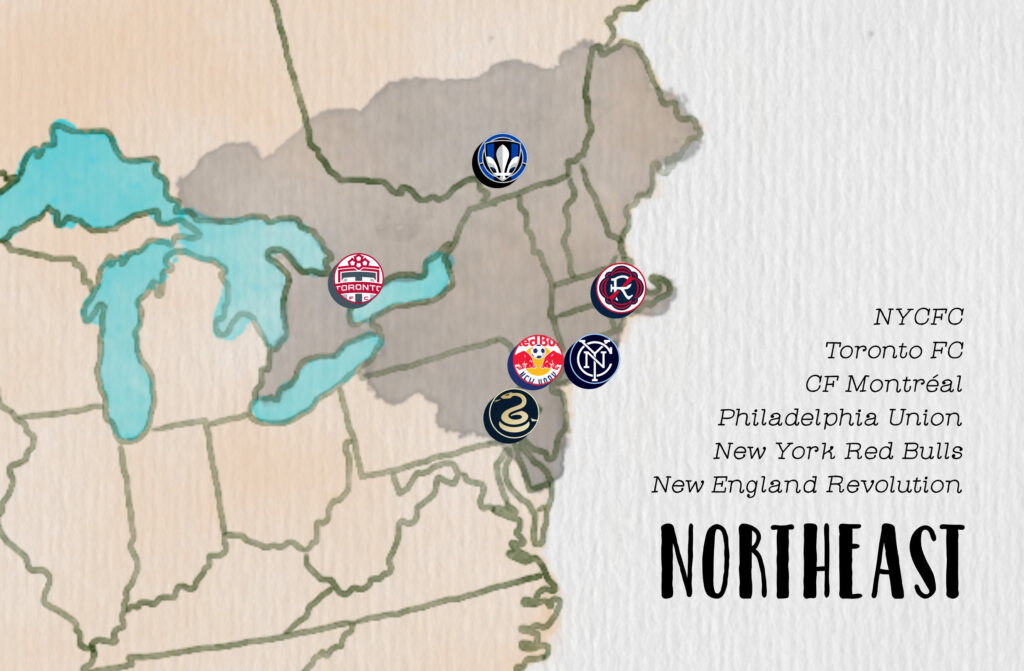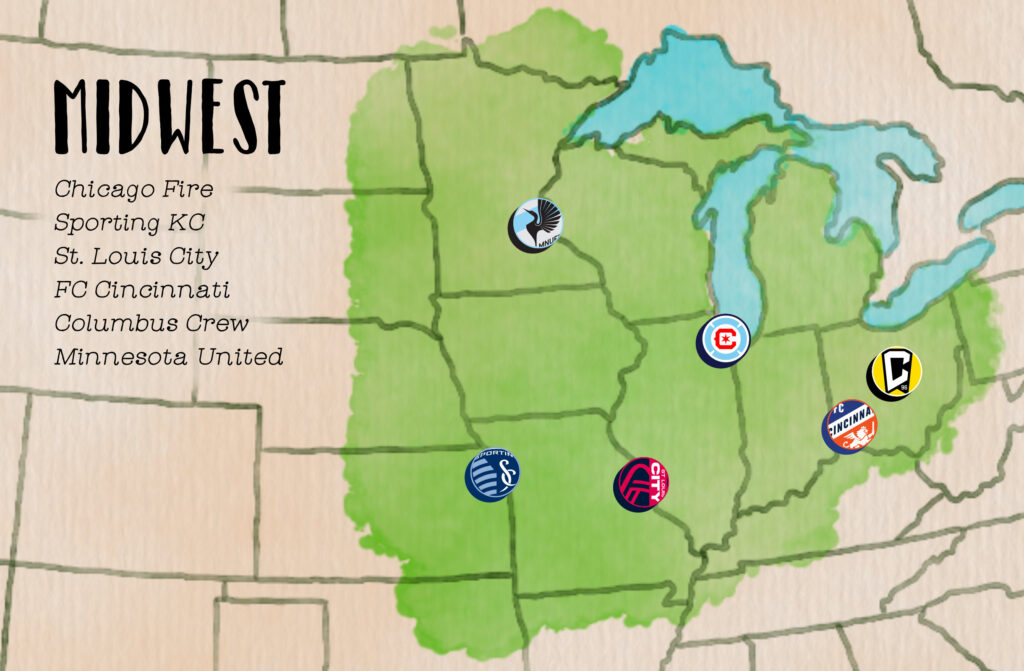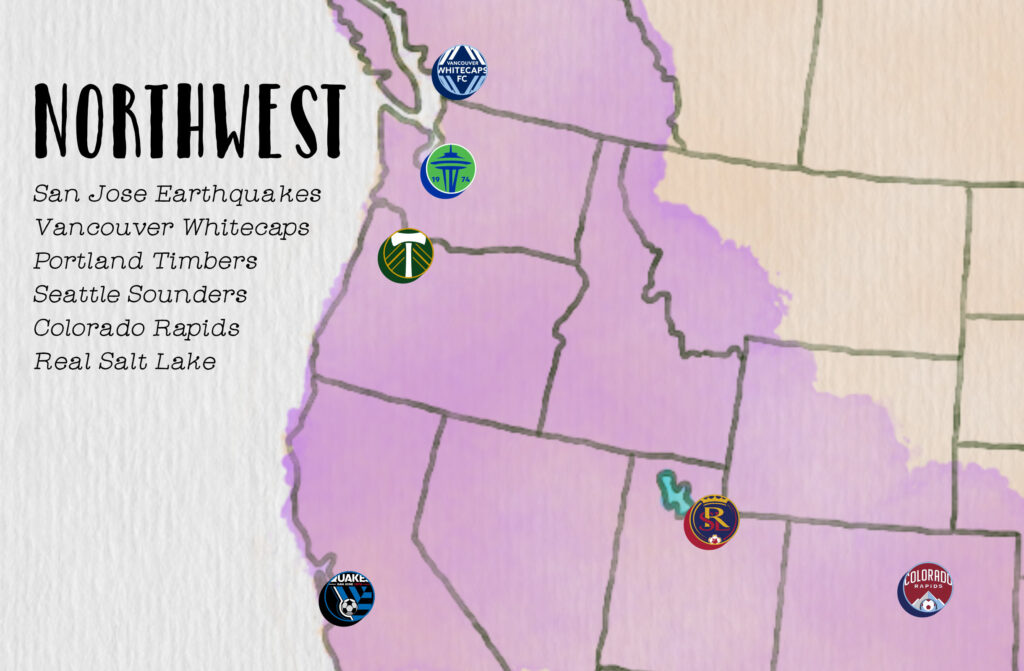The 2025 MLS schedule has dropped, and with that, a 30th team has joined the fray. Welcome, San Diego FC! However, MLS has missed a chance at taking the bold step of getting rid of a legacy American sports construct: CONFERENCES.
Conferences are absolutely unnecessary in MLS and they are instituted by the league on an arbitrary basis. The 2024 New York Red Bulls (NYRB) won the Eastern Conference title for the first time in their history, but it wasn’t their first conference title. In 2008 they won the Western Conference title. Yes, a team from the East Coast which has been in the league from its inception in 1996, won its first conference title against Western Conference foes. That year, the top three teams from each conference made the playoffs, with the two next-best teams serving as Wild Cards. Because both Wild Card teams came from the Eastern Conference, and because NYRB were the 2nd Wild Card team, they were placed on the Western Conference side of the playoffs. Having won the Western Conference title game against Real Salt Lake, they played (and lost to) their normal Eastern Conference foes, Columbus Crew, in the MLS Cup title game.
That same year saw Kansas City playing in the Eastern Conference as well. But in fact, KC started its existence in 1996 in the Western Conference, then moved to the Eastern Conference for a decade between 2005 and 2014, before finally moving back to the Western Conference in 2015.
But muh expansion!
Certainly a lot of this jostling around in early MLS was due to expansion, causing the few teams in the league to switch up sides almost on an annual basis. But are we at a point where towering conferences do more harm than good? There are now so many teams in the league that the conferences are artificially obstructing natural, geographic rivalries (e.g. Chicago (East) & St. Louis (West) & Nashville (East)).
But, but… NFL!
Furthermore, in their current form, they serve to dictate an unbalanced schedule. Teams go years, plural, without playing each other. St. Louis CITY has been in the league for 2 years, yet 2025 will be the first time they play Columbus, Montréal and Philadelphia in league play. That leaves the NY Red Bulls as the lone team St. Louis has yet to face off against. Maybe their fourth year in the league will finally feature this matchup?
On that note, while St. Louis played Charlotte and Toronto in 2023, they did not play them in 2024 and will not play them in 2025. This means that by 2026, again St. Louis’ fourth year in the league, they might play Charlotte and Toronto for only the second time, respectively, ever.
What’s the point
Finally, there is no meaning, purpose or end-goal to conference play. Case in point: St. Louis won the Western Conference in 2023… yet, they weren’t Western Conference Champions. That accolade went to LAFC, which won the Western Conference Championship game in MLS Cup… yet, no one counts that trophy as serious silverware for the team because its actually a semifinal game in the MLS Cup tournament. Since St. Louis bowed out early in MLS Cup, and LAFC lost in the MLS Cup title game, neither team gets any recognition for their conference accomplishments. Conferences are literally worthless vessels!
Introducing REGIONS
Regions are an attempt to embrace natural, geographic rivalries while also allowing for a more balanced schedule. Let’s be honest: the fun part about soccer is being able to easily travel to away rivalry games. Yet St. Louis are forced to travel to Vancouver or Colorado every year while natural rivalries in Chicago and Nashville stagnate.
With 30 teams, we can now set up 5 regions of 6 teams each (detailed below). But first, let’s see how the schedule, standings and playoffs would look.
Schedule
| 34 game season | |
| 10 games | vs. region (1 home/1 away) |
| 24 games | vs. all other teams (alternating home/away yearly) |
Standings
All teams compete in one unified Shield race, with the standings table being 1-30.
Playoffs
Top 14 qualify for MLS Cup, with seeds 15–18 serving as Wild Card entrants. (No breakdown by region in the playoffs. Purely based on Shield seeding.)
NOTE: To ease the burden of traveling across time zones, travel trips should be introduced. For example, if the schedule calls for New England to play away games @LA and @SD, those games should be scheduled back-to-back. Either play them on subsequent weekends or a Saturday + Wednesday combo. New England can then stay out west for the week and not endure travel fatigue.
With all of that out of the way, let’s take a look at how the five regions could take shape!

Northeast Region
| New England Revolution | Philadelphia Union |
| New York Red Bulls | Toronto FC |
| NYCFC | CF Montréal |
The one snag here is splitting Philadelphia away from DC United, but I’m not sure what else to do. New England makes things difficult since we don’t want to split up Toronto/Montréal or NYRB/NYCFC.
Other than that, it’s a nice little region that already has tons of history playing each other.
Furthest road trip
The furthest road trip for supporters is 9 hours between Toronto and New England.
Distances (hours by car)
| NE | NYRB | NYCFC | PHI | TOR | MTL | |
| NE | × | 4.5 | 4 | 6 | 9 | 6 |
| NYRB | 4.5 | × | 1 | 2 | 8 | 6 |
| NYCFC | 4 | 1 | × | 2.5 | 8 | 6 |
| PHI | 6 | 2 | 2.5 | × | 8 | 8 |
| TOR | 9 | 8 | 8 | 8 | × | 6 |
| MTL | 6 | 6 | 6 | 8 | 6 | × |

Southeast Region
| DC United | Nashville SC |
| Charlotte FC | Orlando SC |
| Atlanta United | Inter Miami CF |
Fairly simple regional rivalries here. Orlando and Miami was already nice before Messi & Friends showed up, but now its cooking. Atlanta seem to have Miami squarely in their sights as well, but the fact is they have two regional rivals equidistant to the east and west in both Charlotte and Nashville respectively. Both can be a thorn in Atlanta’s side if they aren’t focused on them.
The odd man out here of course is DC. Again, it would be nice if they could stay with Philly. But without moving teams around in a fantasy scenario we’re always going to have a team like this. The upside for DC is: (a) Charlotte is a reasonable drive away; and (b) every other year they have close away games up I-95 in Philly, NYRB and NYCFC.
Furthest road trip
The furthest road trip for supporters in this region is between DC and Miami at 15 hours. Not ideal, but also nothing new since these two teams already play each other every year in the Eastern Conference. Supporters for each are relying on flights instead.
Distances (hours by car)
| DC | CLT | ATL | NSH | ORL | MIA | |
| DC | × | 6 | 10 | 10 | 12 | 15 |
| CLT | 6 | × | 4 | 7 | 7.5 | 11 |
| ATL | 10 | 4 | × | 4 | 6 | 9.5 |
| NSH | 10 | 7 | 4 | × | 10 | 13.5 |
| ORL | 12 | 7.5 | 6 | 10 | × | 3.5 |
| MIA | 15 | 11 | 9.5 | 13.5 | 3.5 | × |

Midwest Region
| Chicago Fire | Columbus Crew |
| St. Louis CITY | Minnesota United |
| FC Cincinnati | Sporting KC |
The Midwest Region stands to benefit the most from realignment. The rivalry between St. Louis and SKC is only two years old, but already sizzling. Ditto with Columbus and Cincinnati. Neither of those two rivalries can be broken up. Chicago serves as a hub of the region, not too far from any one city. The hope here is that this move can ignite a rivalry between St. Louis and Chicago like they have in other sports. But don’t discount Minnesota in that equation as they are only 6 hours away from Chicago. What could playing each other twice a year mean for a rivalry between those two? Bringing Cincinnati and Columbus into the mix would also set up potential rivalries with St. Louis and SKC, the latter having a long history with Columbus in the league.
Furthest road trip
The furthest road trip for supporters in this region is between Minnesota and Columbus at 11 hours. To me, that’s something you save for a special game (playoffs, title game, etc) instead of attending every year.
Distances (hours by car)
| CHI | STL | CIN | CLB | MIN | SKC | |
| CHI | × | 5 | 4.5 | 5.5 | 6 | 7.5 |
| STL | 5 | × | 5 | 6.5 | 8.5 | 3.5 |
| CIN | 4.5 | 5 | × | 1.5 | 10.5 | 9 |
| CLB | 5.5 | 6.5 | 1.5 | × | 11 | 10 |
| MIN | 6 | 8.5 | 10.5 | 11 | × | 6.5 |
| SKC | 7.5 | 3.5 | 9 | 10 | 6.5 | × |

Northwest Region
| San Jose Earthquakes | Seattle Sounders |
| Colorado Rapids | Portland Timbers |
| Real Salt Lake | Vancouver Whitecaps |
The Western Conference is a lot harder to break up simply because there are fewer teams which are way more spread out. Fortunately in the Northwest Region we have some existing rivalries that we can lean on.
The three Cascadia teams need no introduction and do a fantastic job stoking their rivalry flames. And despite having down years recently, Colorado and Real Salt Lake have a healthy rivalry—battling for the Rocky Mountain Cup every year. The odd man out here is San Jose, which you’d think should remain with the California teams. However, northern Cali does have a connection with Oregon and the Pacific Northwest, so I’m OK with including them in this region.
Furthest road trip
The furthest road trip for supporters is going to be the otherworldly 22 hours between Vancouver and Colorado. The geography of the region is just going to dictate air travel. But, since all of these teams are currently in the Western Conference they are used to playing away games against each other.
Distances (hours by car)
| SJ | COL | RSL | SEA | POR | VAN | |
| SJ | × | 18 | 11 | 12.5 | 10 | 16 |
| COL | 18 | × | 7 | 18.5 | 17.5 | 22 |
| RSL | 11 | 7 | × | 12 | 11 | 14.5 |
| SEA | 12.5 | 18.5 | 12 | × | 3 | 3 |
| POR | 10 | 17.5 | 11 | 3 | × | 6 |
| VAN | 16 | 22 | 14.5 | 3 | 6 | × |

Southwest Region
| LA Galaxy | FC Dallas |
| LAFC | Houston Dynamo |
| San Diego FC | Austin FC |
Again, the vast distances out West dictate a Region that may not seem exactly geographically connected, so here we have somewhat of a compromise. This sets up two mini-regions playing against each other. In one, you have the hot and heavy Galaxy/LAFC rivalry that will now add San Diego into the mix. That can’t be broken up and should make for good watching all around, similar to the three Cascadia teams. Will a new “SoCal Cup” (San Angeles Cup? San Andreas Cup?) be created and contested between the three?
And in the other mini-region, we have another three teams that cannot be broken up in Dallas, Houston and Austin. Those three already play annually for the Copa Tejas and have really good rivalries between each other.
Furthest road trip
The furthest road trip for supporters in this region is going to be 22.5 hours (whew!) between Houston and either Los Angeles team. But obviously this region would be set up better for driving inside each mini-region and flying between the two. Of course since these teams play each other in the current Western Conference, supporters are already used to how they can get to away games.
Distances (hours by car)
| LA | LAFC | SD | DAL | HOU | ATX | |
| LA | × | 0.5 | 2 | 21 | 22.5 | 21 |
| LAFC | 0.5 | × | 2 | 21 | 22.5 | 21 |
| SD | 2 | 2 | × | 19 | 20.5 | 18.5 |
| DAL | 21 | 21 | 19 | × | 4 | 3 |
| HOU | 22.5 | 22.5 | 20.5 | 4 | × | 2.5 |
| ATX | 21 | 21 | 18.5 | 3 | 2.5 | × |
Wrapping it up
There you have it. 5 regions. 6 teams each. All teams play each other at least once per year. Only 1 standings table. Winning your region means nothing. Playoffs are no longer segregated—rather, they are based on seeding, like any other soccer tournament.
The good thing is that MLS, as a league, has been in a state of flux since its founding—with teams constantly shifting conferences and divisions. Trying something new will not upset the apple cart. It is not like a Western Soccer League and an Eastern Soccer League merged to form MLS and now we have to keep all the teams in their respective conferences, because: tradition.
Let’s try something new and double down on the beating heart of soccer—geographic rivalries!